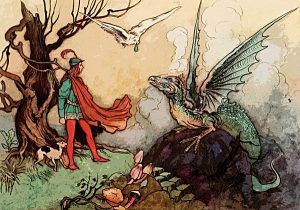Dragon Slaying Metaphor Therapy Technique
Dragon Slaying Metaphor Therapy
Dragon Slaying: Changing behavior by changing the metaphor
Dragon Slaying is an elegant and effective way to change stubborn unconscious behavior. It is a form of metaphor therapy, an intermediate technique between direct metaphor techniques and somatic replacement therapy.
In the metaphor replacement technique the therapist uses the client's internally generated metaphor and develops that. The Dragon Slaying technique supplies the metaphor. The client changes how she feels by changing her visualization of her dragon.
The Dragon Slaying Technique explained
Dragon Slaying works because it utilizes the way metaphoric processes structure our minds. Metaphor theory states that at a fundamental level our minds work in metaphors, and the metaphors we use are exact representation of how our minds structure our problems. If you have a problem, your mind holds that problem as one unique structure and one unique metaphor describes that structure. A different problem will have a different structure and a different metaphor.
Therefore if you examine the metaphor you can learn how their mind represents the problem. However, metaphor theory goes one step further and says that if you change how the metaphor is represented, then the structure underlying the metaphor will alter to match that change. And if you change the structure then you change the problem. Problem behaviour is actually caused by the way your mind is currently structuring your previous experience.
By changing that structure you destroy the thing that is causing the problem, and therefore the instant the structure changes, the problem literally disappears. The dragon slaying technique provides that metaphor and then systematically forces changes to it.
1. Identify the dragon
The client is invited to describe their problem and to re-experience the feelings that are generated when they are in the problem state. The client is then asked to name their state, for example Fear, or Anger or Lost, or whatever word they think best describes it.
2. Describe the dragon
Say to the client: "If this feeling was a dragon, what colour would it be?"
The client might reply: "It's red".
The process then continues by asking ever more detailed questions about the appearance of the dragon.
"Does it have a head?"
"Yes"
"Describe the head."
"It's turned towards me and it's got evil looking eyes."
The client's words are reflected back exactly as heard, using the technique of Clean Language.
"It's a red dragon, and the head is turned towards you and it's got evil looking eyes." [pause] "And what else about that dragon's head?"
"It's got flared nostrils."
"It's a red dragon, the head is turned towards you and it's got evil looking eyes and flared nostrils." [pause] "And what about the neck? What's that like?"
The questioning goes on like that, summarizing what has been said and tacking on another question until the client appears to have exhausted the details of the part being described. The client is then questioned about what the skin looks like, what it feels like, whether it is rough or smooth, and the same for the tail and the back, the feet and so on. Finally ask how big it is.
The end result is a detailed description of the client's visualisation of their dragon.
3. Access the client's feelings
The client is then asked: "Give three words that describe what you feel about the dragon or what the dragon is feeling."
"Fear, Nasty, Anger".
4. Find out the purpose of the dragon
Explain to the client that the dragon is there for a purpose. That the dragon is there for some good reason. Remind the client that there was a time when the dragon was not there.
"How old were you when the dragon first appeared?"
The client will usually be able to give an age or an event, and may spontaneously give the circumstances that caused the state to emerge.
Ask: "What is it that the dragon is trying to do for you?"
The client will usually come up with some relevant positive behaviour, for example "Keep me away from my mother, to be in between and stop me getting noticed and annoying her. To protect me. "
5. Explore what the client would feel like without the dragon
"How would you feel if you didn't have to be in this state? If you got what it is your dragon is trying to give you?"
"I'd feel fantastic. I wouldn't be exhausted all the time, or upset."
Encourage the client to list all the positive things that would happen. Then tell the client that this is what the dragon is trying to do, which is why trying to get rid of it causes such fierce resistance.
Ask "what is on the other side of the dragon".
Often the client will generate more positive words such as Peace or Acceptance or similar.
6. Negotiate a change in the dragon.
Restate the description of the dragon, for example "It's an angry, nasty, feared, red dragon with rough hot skin like fish scales, a head turned towards you with evil looking eyes and flared nostrils, feet with sharp claws.... and so on."
The ask the client to state the word that is opposite the first word "angry". The client might say "Happy". You then restate the entire description but substituting the word 'happy' for 'angry' - "It's a happy, nasty, feared, red dragon with rough hot skin like fish scales...." . You then ask the client to give you a word as the opposite of each of the negative words originally used.
You eventually end up with a description such as "It's a happy, good, calm, pink dragon with fluffy short fur, a smiling head with kind eyes and normal nostrils, small soft feet like slippers...." etc.
7. Test the new state
Ask the client how they feel about the dragon now.
Usually they will say "It feels different, more friendly".
Ask what is happening with the dragon.
Usually the client will report that is it smaller, or moving away. Sometimes the client spontaneously releases the dragon and reports that it has gone.
8. Dismiss the dragon
Ask the client if they want to kill the dragon or just make it go away.
The client will choose one of the options.
Ask the client what would need to happen next. Suggest looking really closely at the dragon to see if there is anything they missed the first time, like wings. Or if the client wants to kill the dragon tell them that dragons live in really messy surroundings like junk yards and there are usually things lying around. Tell the client to look for things that could be used.
Depending on what option the client chose they will make further changes. It is common to report that the dragon has flown up into the clouds. Or that the client has found a sword and cut off the dragon's head.
9. Test the old state
When the client has finished the changes test the state. Ask the client to re-imagine their original problem situation, to bring back the feeling they used to have. The feeling they had twenty minutes ago.
In most cases the client will report that they cannot get that old feeling back again. Then get them to imagine more and more extreme cases to make sure that the state has gone.
Occasionally the client will report that the feeling is still there, "but not so bad." In that case repeat the process from the beginning. Go through the whole process of envisioning the dragon and changing it. Usually the client will describe the dragon as being much smaller, "like a baby dragon" and a different colour, pink instead of red, for example.
10. Rehearse the change
To finalise the session, the therapist makes sure that the change is complete using guided imagery exercises. The therapist will take the client through a complete cycle of whatever was their problem from the first step through to a happy conclusion and makes sure that there are no lingering doubts or discomfort with the various scenarios.
MFRT01

Special offers
Combine Metaphor
Scripts with other
collections and save.
Some half price!
Have a Look!.






